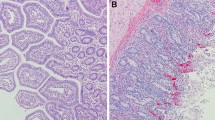Abstract
The effect of the antisecretory factor (ASF) on experimental porcine enterotoxin-induced jejunal secretion was tested. The heat-labile enterotoxin (LT) fromEscherichia coli and cholera toxin (CT) was used for challenge in ligated intestinal loops. Less than 10 units of ASF inhibited the LT-induced secretion, while that due to CT required more than 10 units of ASF. ASF was effective only when administered prior to toxin challenge, and could be given either intravenously or intra-intestinally. Mixing of ASF with specific anti-ASF antibodies prior to injection abolished its antisecretory effect. LT- and CT-induced secreted fluid contained equal concentrations of Na+, K+ and Cl−, and the ionic concentration was not affected by ASF. Less than 0.1 units of ASF per pituitary gland was present in 3- and 5-week old pigs, while it increased to 4.5 units in 28-week old animals, and to 12.2 units in pigs older than two years. However, after intra-intestinal vaccination with 2.0 mg CT, the pituitary ASF content in the 5-week old animals increased to 2.0 units within 24h.
Similar content being viewed by others
Abbreviations
- ASF:
-
antisecretory factor
- CT:
-
cholera toxin
- LT:
-
the heat-labile enterotoxin fromEscherichia coli
References
Argenzio RA (1980) Glucose-stimulated fluid absorption in the pig small intestine during the early stage of swine dysentery. Am J Vet Res 41:2000–2006
Carpenter CCJ (1972) Cholera and other enterotoxin-related diarrheal diseases. J Infect Dis 126:551–564
Cooke HJ (1986) Neurobiology of the intestinal mucosa. Gastroenterology 90:1057–1081
Craig IP (1972) The enterotoxic enteropathies. In: Smith H, Pearce JH (eds) Microbial pathogenicity in man and animals. Cambridge University Press, Cambridge. pp 129–155
Field M (1976) Regulation of active ion transport in the small intestine. In: Elliot K, Knight I (eds) Acute diarrhea in childhood. Ciba Foundation, Symposium 42. Elsevier, Amsterdam, pp 109–122
Hirst TR, Sanchez I, Kapu IB, Hardy JSJ, Holmgren J (1984) Mechanism of toxin secretion byVibrio cholerae investigated in ofEscherichia coli. Proc Natl Acad Sci USA 81:7752–7756
Kimberg DV (1974) Cyclic nucleotides and their role in gastrointestinal secretion. Gastroenterology 67:1023–1064
Lange S (1982) A rat model for anin vivo assay of enterotoxic diarrhea. Microbiol Lett 15:239–242
Lange S, Lönnroth I (1984) Passive transfer of protection against cholera toxin in the rat intestine. Microbiol Lett 24:165–168
Lange S, Lönnroth I (1984) Bile and milk from cholera toxin treated rats contain a hormone-like factor which inhibits diarrhea induced by the toxin. Int Arch Allergy Appl Immunol 79:270–275
Lange S, Lönnroth I, Palm A, Hydén H (1985) An inhibitory protein of intestinal fluid secretion reverses neuronal GABA transport. Biochem Biophys Res Commun 130:1032–1036
Lönnroth I, Lange S (1984) Purification and characterization of a hormone-like factor which inhibits cholera secretion. FEBS Lett 177:104–108
Lönnroth I, Lange S (1985) A hormone-like protein from the pituitary gland inhibits intestinal hypersecretion induced by cholera toxin. Regul Pept (Suppl 4) 216–218
Lönnroth I, Lange S (1986) Purification and characterization of the antisecretory factor — a protein in the central nervous system and in the gut which inhibits intestinal hypersecretion induced by cholera toxin. Biochim Biophys Acta 883:138–144
Lönnroth I,Hannson H-A, Lange S (1984) Intestinal adaption to cyclic AMP-mediated hypersecretion induced by heat-labile enterotoxin ofVibrio cholerae andEscherichia coli. Acta Pathol Microbiol Immunol Scand (B) 92:53–60
Morishita T, Hibi T, Asakuva H, Tsuchiya M (1977) Clinical studies on cholera-variation of blood hormones and amines in a course of cholera. In: Fukumi H, Zinnaka Y (eds) Proc 12th Joint Conf US-Japan cooperative medical science program cholera panel. National Institute of Health, Tokyo, pp 65–71
Sack RB (1975) Human diarrheal disease caused by enterotoxigenicEscherichia coli. Annu Rev Microbiol 29:333–354
Skadhauge E (1978) Analysis of computer models. In: Gupta BL, Moreton RB, Oschman SL, Wall BJ (eds) Transport of ions and water in animals. Academic Press, London, pp 145–165
Smyth CI, Olsson E, Moncalvo C, Söderlind O, Örskov F, Örskov I (1981) K99 antigen-positive enterotoxigenicEscherichia coli from piglets with diarrhea in Sweden. J Clin Microbiol 13:252–257
Author information
Authors and Affiliations
Rights and permissions
About this article
Cite this article
Lange, S., Lönnroth, I. & Skadhauge, E. Effects of the antisecretory factor in pigs. Pflugers Arch. 409, 328–332 (1987). https://doi.org/10.1007/BF00583485
Received:
Accepted:
Issue Date:
DOI: https://doi.org/10.1007/BF00583485




